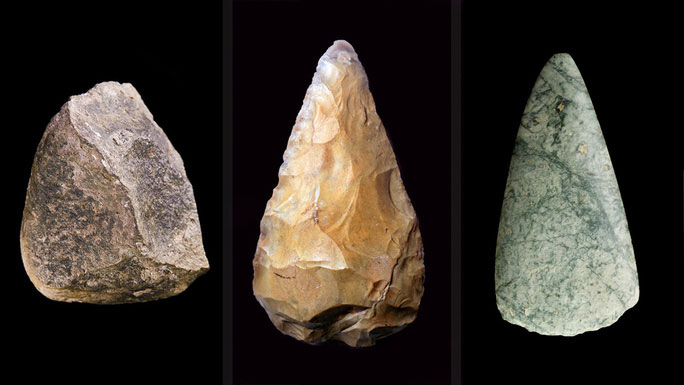The origins of the stone tool usage behavior of humans during the Stone Age began in a surprisingly unexpected way, revealed through a remarkable experiment conducted by the University of Tübingen and the Max Planck Institute for Evolutionary Anthropology.
According to Sci News, orangutans (Pongo pygmaeus) were tested for their ability to use primitive tools that humans utilized during the Stone Age. These include a type of stone hammer and flint knife, with artifacts excavated dating back approximately 3.3 million years.
Dr. Monte-Rodrigo from the Department of Prehistoric Ecology and Quaternary Studies at the University of Tübingen (Germany), the lead author of the study, conducted experiments on five untrained orangutans.

Prehistoric stone tools – (Photo: History).
In the first experiment, they tested the orangutans’ ability to create and use tools by providing them with a concrete hammer, a rough stone core, and two food containers. To access the food, the orangutans needed to create something sufficient to cut through the strings and the silicone covering to open the boxes.
However, the two orangutans only struck the hammer against the floor and walls of their enclosure, not aiming at the stone core.
But the second experiment brought surprising results. This time, the orangutans were given a sharp flint piece similar to the stone tools made by prehistoric humans, sufficient to cut through the silicone to open the food containers. The scientists crafted this flint piece in front of three other orangutans by using the concrete hammer to strike the stone core to create sharp edges, allowing the two previously tested orangutans to observe.
The three orangutans provided with the flint knives demonstrated that they could easily use them to cut through the silicone covering and retrieve food from the boxes.
Interestingly, one female orangutan among the initial two began to imitate humans, using the concrete hammer to strike the stone core at the edges to create her own cutting tool similar to the others!
This result suggests two prerequisites for the emergence of stone tools: the recognition of sharp stones as cutting tools and the knowledge of how to strike to create sharp stone fragments, which may have existed since the time of our last common ancestor with orangutans, approximately 13 million years ago.
The findings were recently published in the journal PLOS One.


















































